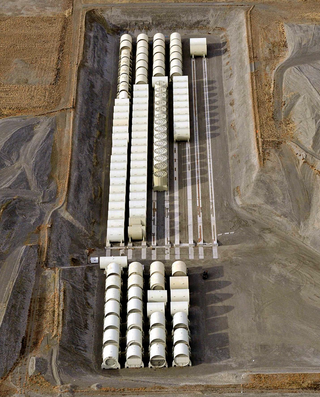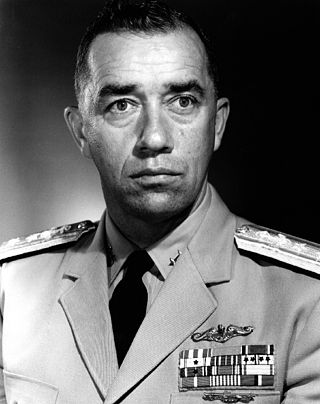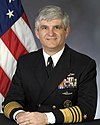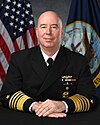
Deep Submergence Vessel NR-1 was a unique United States Navy (USN) nuclear-powered ocean engineering and research submarine, built by the Electric Boat Division of General Dynamics at Groton, Connecticut. NR-1 was launched on 25 January 1969, completed initial sea trials 19 August 1969, and was home-ported at Naval Submarine Base New London. NR-1 was the smallest nuclear submarine ever put into operation. The vessel was casually known as "Nerwin" and was never officially named or commissioned. The U.S. Navy is allocated a specific number of warships by the U.S. Congress, but Admiral Hyman Rickover avoided using one of those allocations for the construction of NR-1 in order to circumvent the oversight that a warship receives from various bureaus.

United States naval reactors are nuclear reactors used by the United States Navy aboard certain ships to generate the steam used to produce power for propulsion, electric power, catapulting airplanes in aircraft carriers, and a few more minor uses. Such naval nuclear reactors have a complete power plant associated with them. All U.S. Navy submarines and supercarriers built since 1975 are nuclear-powered by such reactors. There are no commissioned conventional (non-nuclear) submarines or aircraft carriers left in the U.S. Navy, since the last conventional carrier, USS Kitty Hawk, was decommissioned in May 2009. The U.S. Navy had nine nuclear-powered cruisers with such reactors also, but they have since been decommissioned. Reactors are designed by a variety of contractors, then developed and tested at one of several government owned and prime contractor-operated facilities: Bettis Atomic Power Laboratory in West Mifflin, Pennsylvania and its associated Naval Reactors Facility in Idaho, and Knolls Atomic Power Laboratory in Niskayuna, New York and its associated Kesselring site in West Milton, New York, all under the management of the office of Naval Reactors. Sometimes there were full-scale nuclear-powered prototype plants built at the Naval Reactors Facility, Kesselring, and Windsor to test the nuclear plants, which were operated for years to train nuclear-qualified sailors.

Hyman G. Rickover was an admiral in the United States Navy. He directed the original development of naval nuclear propulsion and controlled its operations for three decades as director of the U.S. Naval Reactors office. In addition, he oversaw the development of the Shippingport Atomic Power Station, the world's first commercial pressurized water reactor used for generating electricity. Rickover is also one of four people who have been awarded two Congressional Gold Medals.

USS Thresher (SSN-593) was the lead boat of her class of nuclear-powered attack submarines in the United States Navy. She was the U.S. Navy's second submarine to be named after the thresher shark.

USS Triton (SSRN/SSN-586), the only member of her class, was a nuclear powered radar picket submarine in the United States Navy. She had the distinction of being the only Western submarine powered by two nuclear reactors. Triton was the second submarine and the fourth vessel of the United States Navy to be named for the Greek god Triton, At the time of her commissioning in 1959, Triton was the largest, most powerful, and most expensive submarine ever built at $109 million excluding the cost of nuclear fuel and reactors.

Nuclear marine propulsion is propulsion of a ship or submarine with heat provided by a nuclear reactor. The power plant heats water to produce steam for a turbine used to turn the ship's propeller through a gearbox or through an electric generator and motor. Nuclear propulsion is used primarily within naval warships such as nuclear submarines and supercarriers. A small number of experimental civil nuclear ships have been built.
A nuclear navy, or nuclear-powered navy, refers to the portion of a navy consisting of naval ships powered by nuclear marine propulsion. The concept was revolutionary for naval warfare when first proposed. Prior to nuclear power, submarines were powered by diesel engines and could only submerge through the use of batteries. In order for these submarines to run their diesel engines and charge their batteries they would have to surface or snorkel. The use of nuclear power allowed these submarines to become true submersibles and unlike their conventional counterparts, they became limited only by crew endurance and supplies.

USS Hyman G. Rickover (SSN-709), a Los Angeles-class submarine, was the first ship of the United States Navy to be named for Admiral Hyman G. Rickover, pioneer of the nuclear Navy, and the only Los Angeles-class submarine not named after a United States city or town. She was initially to be named USS Providence; however, following the retirement of Admiral Rickover, her name was reassigned prior to official christening. SSN-719 was later given the name USS Providence.

Vice Admiral William Wohlsen Behrens Jr. was an American naval officer and oceanographer who was instrumental in establishing the National Oceanic and Atmospheric Administration.

Kirkland Hogue "Kirk" Donald is a retired Admiral in the United States Navy, who in his last assignment served as the dual-hatted position of Director of Naval Nuclear Propulsion and Deputy Administrator of the National Nuclear Security Administration. Donald previously served as Commander, Submarine Force, U.S. Atlantic Fleet, and Commander, Submarine Allied Command, Atlantic. He retired from active duty on November 2, 2012.
The United States Navy's Bureau of Ships (BuShips) was established by Congress on 20 June 1940, by a law which consolidated the functions of the Bureau of Construction and Repair (BuC&R) and the Bureau of Engineering (BuEng). The new bureau was to be headed by a chief and deputy-chief, one selected from the Engineering Corps (Marine Engineer) and the other from the Construction Corps (Naval Architect). The chief of the former Bureau of Engineering, Rear Admiral Samuel M. "Mike" Robinson, was named BuShips' first chief, while the former chief of the Bureau of Construction & Repair, Rear Admiral Alexander H. Van Keuren, was named as BuShips' first Deputy-Chief. The bureau's responsibilities included supervising the design, construction, conversion, procurement, maintenance, and repair of ships and other craft for the Navy; managing shipyards, repair facilities, laboratories, and shore stations; developing specifications for fuels and lubricants; and conducting salvage operations.

Eugene Parks "Dennis" Wilkinson was a United States Navy officer. He was selected for three historic command assignments. The first, in 1954, was as the first commanding officer of USS Nautilus, the world's first nuclear-powered submarine. The second was as the first commanding officer of USS Long Beach, America's first nuclear surface ship. The third was in 1980 when he was chosen as the first President and CEO of the Institute of Nuclear Power Operations (INPO) from which he retired in 1984.

Kinnaird Rowe McKee was an American United States Navy four star admiral who served as Director, Naval Nuclear Propulsion from 1982 to 1988. He also served as Superintendent, United States Naval Academy from 1975 to 1978.
Alvin Radkowsky was an American nuclear physicist and chief scientist at U.S. Navy nuclear propulsion division. His work in the 1950s led to major advances in nuclear-ship technology and civilian use of nuclear power.

Nuclear Power School (NPS) is a technical school operated by the U.S. Navy in Goose Creek, South Carolina as a central part of a program that trains enlisted sailors, officers, KAPL civilians and Bettis civilians for shipboard nuclear power plant operation and maintenance of surface ships and submarines in the U.S. nuclear navy. As of 2020 the United States Navy operates 98 nuclear power plants, including 71 submarines, 11 aircraft carriers, two Moored Training Ships (MTS) and two land-based training plants. NPS is the centerpiece of the training pipeline for U.S. Navy nuclear operators. It follows initial training at Nuclear Field "A" School or a college degree, and culminates with certification as a nuclear operator at one of the Navy's two Nuclear Power Training Units (NPTU).
The UGM-89 Perseus was a proposed U.S. Navy submarine-launched anti-ship (AShM) and anti-submarine (ASW) cruise missile that was developed under the Submarine Tactical Missile (STAM) project, which was also referred to as the Submarine Anti-ship Weapon System (STAWS). This missile system was to be the centerpiece for a proposed third-generation nuclear-powered cruise missile submarine championed by then-Vice Admiral Hyman G. Rickover, the influential but controversial head of the Navy's nuclear propulsion program.

The Naval Sea Systems Command (NAVSEA) is the largest of the United States Navy's five "systems commands," or materiel organizations. From a physical perspective, NAVSEA has four shipyards for shipbuilding, conversion, and repair, ten "warfare centers", the NAVSEA headquarters, located at the Washington Navy Yard, in Washington D.C., and other locations in 15 states and 3 overseas continents.
The United States Navy Nuclear Propulsion community consists of Naval Officers and Enlisted members who are specially trained to run and maintain the nuclear reactors that power the submarines and aircraft carriers of the United States Navy. Operating more than 80 nuclear-powered ships, the United States Navy is currently the largest naval force in the world.
Edwin E. Kintner (1920–2010) was an American nuclear pioneer and engineer and a U.S. Navy captain who was in charge of de-contamination of the Three Mile Island accident.

Vice Admiral Thomas J. Moore was a senior officer in the United States Navy. He retired from active duty on June 19, 2020, after 39 years of service. He currently serves as Vice President of Nuclear Operations at Huntington Ingalls Industries.






















